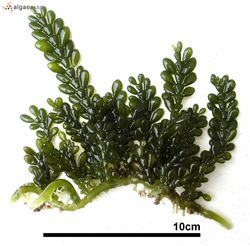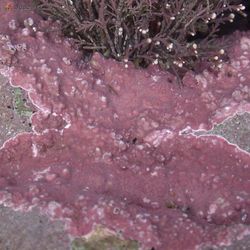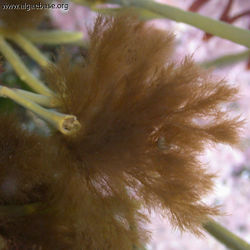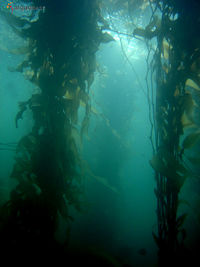Diversity and classification of marine benthic algae
Introduction
Chlorophyllian photosynthesis is responible of almost all primary production at global level and represents the most fundamental process for the support and maintenance of life on our planet. Organisms performing photosynthesis occur in every habitat in which sunlight is available. Whereas vascular plants are largely responsible of photosynthesis on land, in aquatic habitats this process is mainly perfomed by the wide and heterogeneous complex of organisms called algae.
In the widest sense, algae are defined as oxygenic photosynthesizers other than embryophyte land plants (Cavalier-Smith, 2007[1]). In recent years our knowledge of these organisms has greatly advanced, thanks to new types of data (mainly electron microscopy observations and DNA sequence data). Based on these data, we know now that algae represent an artificial and unnatural agglomeration of very different organisms, sharing the only common characteristic of living in aquatic habitats. Algae living in the sea are typically subdivided in plankton (the complex of microscopic algae not visible with unaided eye, which live floating in the water) and benthos (the collectivity of the algae that live attached to the sea bottom).
The algae that form the benthos are plant-like organisms, very diverse and very different in size, shape and colour; they are are typically designated with the term seaweeds. Despite of the undeserved negative connotation associated with such a name, seaweeds play a fundamental role marine ecosystems, where they have a multitude of beneficial effects. Although unrecognized, they also have an important part in our everyday life. Substances extracted from seaweeds occur in toothpastes, shampoos, cosmetics, drugs, soups, ice creams, soft drinks, beer, jellies, marmelades, salad dressings, chewing gums and many other products of large use. In China, Korea and Japan some species of seaweeds are among the most popular foods, and for this reason they have been farmed for many centuries.
Seaweeds occur on any shore where a hard bottom or any other type of stable surfaces are present. From a systematic point of view they are divided in three groups, whose empirical distinction is based on the colour: green algae, red algae and brown algae. The distinction of these three groups, however, is much more substantial than indicated by this simple designation. Besides the colour, they differ in their photosynthetic pigments, storage compounds, composition of cell walls, presence/absence of flagella, ultrastructure of mitosis, fine structure of the chloroplasts and several other characters. The separation of these three groups is so deep and substantial that in recent classification schemes they are classified into different kingdoms. While green and red algae are considered plants (kingdom Plantae), brown algae belong to a different kingdom called Chromista (Cavalier-Smith, 2007[1]). This separation is due to the evolutionary origin of these groups. All eukaryotic algae originated through a process called endoymbiosis, in which a unicellular organism was captured and incorporated by another unicellular organism.
Instead than being killed and digested, the organism incorporated remained alive in its host and established a symbiotic relationship with it. Green algae and red algae were created by primary endosymbiosis. In this process, a unicellular photosynthetic cyanobacterium was incorporated by a larger non-photosythetic eukaryote. Performing photosynthesis, the cyanobaterium had a beneficial effect on its host and was maintained alive; gradually in time, the cyanobacterium established a strict metabolic relationship with the host and underwent deep modifications, becoming the chloroplast of the modern green and red algae. Conversely, brown algae originated through secondary endosymbiosis. In this process, a unicellular red alga was incorporated by a unicellular, non-photosyntetic eukaryote. Once again, the red alga was kept alive by his host and established a strict metabolic relationship with it; the symbiosis of the two organisms produced the ancestral brown alga.
Green algae
The green algae represent a very diverse group, which includes members distributed not only in the sea, but also in freshwater and terrestrial habitats. Their classification has been revised in recent years, based on DNA sequence data. In the current definition, green algae do not form a homogeneous and coherent entity; they are part of a larger group called Viridiplantae, in which the land plants are also included (Lewis & McCourt, 2004[2]). However, all marine green algae are classified in a common class, called Ulvophyceae. The Ulvophyceae are a very diverse group and include about 920 species, which are distributed in all seas of the world.
In the green seaweeds, the body of the alga shows a great range of variation of forms, but usually its morphology is quite simple. Thin filaments, either branched or not, are a common growth form and are found in Cladophora (Figure 1) and Chaetomorpha, two widespread genera. Sheets formed by two layers of cells are typical of Ulva (Figure 2). Because of their appearance, species of this genus are popularly called sea lettuce. These algae are well known for their fast growth and high capacity to adsorb nutrients from seawater.
An abundant growth of Ulva is a common phenomenon in eutrophic waters; when such growth becomes uncontrolled, the accumulation of large masses of Ulva produces the so-called green tides, which may require mechanical removal of the algal biomass. A type of body organization which is unique to the green seaweeds is the so-called siphonalean organization (or coenocytic organization). Siphonalean green algae are classified in two orders, Bryopsidales and Dasycladales, and are among the most ecologically successful seaweeds. The body of these algae is formed by one single giant cell, which contains numerous nuclei. The best-known example of siphonalean seaweeds is represented by the genus Caulerpa. Species of this genus consist of a creeping stolon (that grows attached to the rocky bottom), from which numerous erect frond of variable shape arise (Figure 3). Species of Caulerpa are distributed in tropical and warm-temperate seas. Because of their beautiful habit, they are very popular among aquarium hobbyists and are widely used in tropical aquaria (Stam et al., 2006[3]). Unfortunately, algae of this genus have often the tendency to grow in aggressive and uncontrolled manner. The spread of Caulerpa taxifolia (Figure 4) in the Mediterranean Sea, which occurred after accidental release from the Monaco Oceanographic Museum, has represented one of the most spectacular events of invasion by a marine organism. In subsequent years, a population of Caulerpa racemosa var. cylindracea introduced in an unknown way from Australia has also invaded aggressively the Mediterranean (Verlaque et al., 2003[4]; Piazzi et al., 2005[5]). Other common genera with siphonalean organization are Codium, Acetabularia, Halimeda, Udotea and Valonia. Halimeda has a peculiar appearance; it is a branched alga, whose body is formed by many connected segments with the shape of coins, wedges or sausages (Figure 5). This genus is widespread in tropical seas and is particularly important in the atolls. Its cell walls accumulate calcium carbonate in the form of calcite; after the death of the alga, this material is released and contributes to produce the white sand typical of atoll beaches.
Red algae
The red algae are one of the most ancient groups of eukaryotic algae (fossils of Bangiomorpha pubescens, believed to be the oldest red alga, are 1.2 billions years old). A distinctive characteristic of this group is that they are the only seaweeds lacking flagella (as well as centrioles and other structures typical of the flagellar apparatus) at any stage of their life histories (Maggs et al., 2007[6]). Their colour, which ranges from pink to bright red, purple or sometimes dark brown, is due to the presence of pigments called phycobilins. At present, about 6,000 red algal species are recognized. They have a complex life history, which usually involves the alternation of three generations (gametophyte, carposporophyte and tetrasporophyte).
Their sexual reproductive apparatus is a very sophisticated structure, whose arrangement has been used for a long time as the main criterion for taxonomy at ordinal level. Molecular data produced in the last two decades have revolutionised the classification of these organisms, which belong to a single phylum, the Rhodophyta, subdivided in two subphyla (Cyanidiophytina and Rhodophytina), seven classes (Cyanidiophyceae, Bangiophyceae, Compsopogonophyceae, Florideophyceae, Porphyridiophyceae, Rhodellophyceae and Stylonematophyceae) and 33 orders (Saunders & Hommersand, 2004[7]; Yoon et al., 2006[8]).
The red algae show a great range of morphological variation. The simplest forms consist of single cells like Porphyridium or thin filaments like Bangia. The habit of expanded blades is found in many genera, including some of the most spectacular, such as Delesseria (Figure 6), Polyneura and Halymenia. A widespread and economically important genus with blade-like habit is Porphyra (Figure 7). Porphyra yezoensis and similar species are popularly known with the japanese name of nori and have been used as food for many centuries in eastern Asia; they are the seaweeds used as wrap for sushi. In other red algae, the body of the alga is formed by a crust which grows attached to the rocky bottom. A typical example is represented by species of the order Corallinales, in which the cell walls accumulate calcium carbonate in the form of aragonite, conferring to their body a robust and coriaceous consistence. Algae of this order, such as Lithophyllum, Lithothamnion (Figure 8) and Phymatolithon, look like pink or red calcified crusts, which are very resistent to grazing and mechanical dislodgement; they often thrive on very exposed rocky shores, where seaweeds with soft tissues would be easily dislodged by the violence of the waves. Many other species of red seaweeds have a branched plantlike shape and look like small bushes or trees. Species with this habit include many common genera, such as Chondrus, Gelidium (Figure 9), Gigartina, Gracilaria, Hypnea and Laurencia. Species of Eucheuma and Kappahycus are the most important source of carrageenans (compounds widely used in the food industry), and for this purpose they are farmed on large scale in tropical regions, especially Philippines and Indonesia.
Brown algae
The brown algae are represented by about 1,780 species, currently classified in the class Fucophyceae (or Phaeophyceae) of the phylum Ochrophyta (De Reviers et al., 2007[9]); the class includes 17 orders. Brown seaweeds are not close relatives of red and green seaweeds, although they are macroscopically similar and live mixed together on rocky shores. They belong to a different kingdom (Chromista) and their closest relatives are microscopic algae which live in the plankton of seas and lakes (diatoms, chrysophytes, xanthophytes). Brown seaweeds are distributed in all seas of the world, but they are most diverse and abundant in cold seas; in particular their largest-sized and most spectacular representatives (species of the orders Laminariales and Desmarestiales) are entirely confined to polar and cold-temperate waters. Despite of this general trend, however, this group includes also some genera which are very common and diverse in tropical seas, such as Sargassum (Figure 10) and Turbinaria.
The diversity of forms and shapes of the brown seaweeds is not inferior to that of the green and red seaweeds. Filamentous species consisting of thin branched threads, such as Ectocarpus and Pylaiella (Figure 11), grow on rock or on larger seaweeds in the intertidal zone of many regions of the world. Most brown algae, however, have a bigger size and look like branched ribbons, bushes or small trees. Members of the order Fucales are algae of particular ecological importance, as they form dense belts in the intertidal zone of many rocky shores of temperate seas. For this reason, they produce a type of habitat that supports a great biological diversity and are considered keystone species; the belts of Fucus (Figure 12) in the northern Atlantic and Cystoseira (Figure 13) in the Mediterranean are well known-examples. This order also includes the only example of a macroalga which lives floating permanently and is never attached to the rocky bottom: the Sargasso Sea, located in the middle of the North Atlantic Ocean, is an area delimited by oceanic currents in which large masses of Sargassum float permanently.
The largest known algae are also species of brown seaweeds; they belong to the order Laminariales and are designated with the term kelps. The giant Pacific kelp Macrocystis pyrifera (Figure 14) is the seaweed with the largest size. It can reach 60 metres in length and forms dense forests on the Pacific shores of Canada and U.S.A. Similar submerged forests are produced in other parts of the world by species of Ecklonia, Eisenia, Laminaria and Lessonia. The kelps are also the most complex algae from an anatomic and morphological point of view, as their tissues contain types of cells and structures with complexity comparable to those of vascular plants.
ACKNOWLEDGEMENTS. I am very grateful to the Marine Institute of Ireland for
financial support received under the National Marine Biodiscovery Program. I am
also thankful to Michael Guiry, Rob Anderson, John Bolton, Olivier De Clerck, Katrin
Österlund, Erasmo Macaya, Eduardo Infantes Oanes, Colin Bates, Yukihiko Serisawa and Heroen
Verbruggen for use of pictures, obtained from AlgaeBase (www.algaebase.org).
Related articles
References
- ↑ 1.0 1.1 Cavalier-Smith, T. (2007). Evolution and relationships of algae: major branches of the tree of life. In Unravelling the algae: the past, present and future of algal systematics, eds J. Brodie and J. Lewis, pp 21-55. CRC Press, Boca Raton, London and New York.
- ↑ Lewis, L.A. & McCourt, R.M. (2004). Green algae and the origin of land plants. American Journal of Botany, 91: 1535-1556.
- ↑ Stam, W., Olsen, J.L., Zaleski, S.F., Murray, S.N., Brown, K.R. & Walters, L.J. (2006). A forensic and phylogenetic survey of Caulerpa species (Caulerpales, Chlorophyta) from the Florida coast, local aquarium shops and e-commerce: establishing a proactive baseline for early detection. Journal of Phycology, 42: 1113-1124.
- ↑ Verlaque, M., Durand, C., Huisman, J. M., Boudouresque, C. F. & Parco, Y. (2003). On the identity and origin of the Mediterranean invasive Caulerpa racemosa (Caulerpales, Chlorophyta). European Journal of Phycology, 38: 325–339.
- ↑ Piazzi, L., Meinesz, A., Verlaque, M., Açali, B., Antolic, B., Argyrou, M., Balata, D., Ballesteros, E., Calvo, S., Cinelli, F., Cirik, S., Cossu, A., d'Archino, R., Djellouli, A.S., Javel, F., Lanfranco, E., Mifsud, C., Pala, D., Panayotidis, P., Peirano, A., Pergent, G., Petrocelli, A., Ruitton, S., Zuljevic, A. & Ceccherelli, G. (2005). Invasion of Caulerpa racemosa var. cylindracea (Caulerpales, Chlorophyta) in the Mediterranean Sea: an assessment of the spread. Cryptogamie, Algologie, 26: 189-202.
- ↑ Maggs, M.A., Verbruggen, H. & De Clerck (2007). Molecular systematics of red algae: building future structures of firm foundations. In Unravelling the algae: the past, present and future of algal systematics, eds J. Brodie & J. Lewis, pp. 103-121. CRC Press, Boca Raton, London & New York.
- ↑ Saunders, G.W. & Hommersand, M.H. (2004). Assessing red algal supraordinal diversity and taxonomy in the context of contemporary systematic data. American Journal of Botany, 91, 1494-1507.
- ↑ Yoon, H.S., Müller, K.M., Sheath, R.G., Ott, F.D. & Bhattacharya, D. (2006). Defining the major lineages of red algae. Journal of Phycology, 42: 482-492.
- ↑ De Reviers, B., Rousseau, F. & Draisma, S.G.A. (2007). Classification of the Phaeophyceae from past to present and current challenges. In Unravelling the algae: the past, present and future of algal systematics, eds J. Brodie & J. Lewis, pp. 267-284. CRC Press, Boca Raton, London & New York.
Please note that others may also have edited the contents of this article.
|















